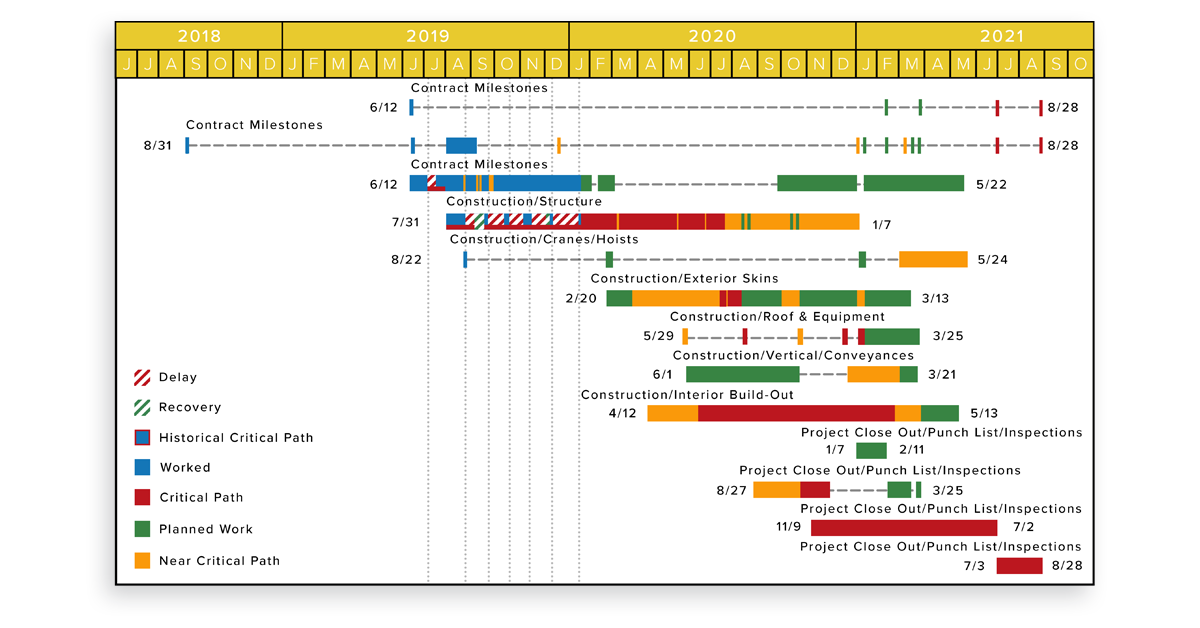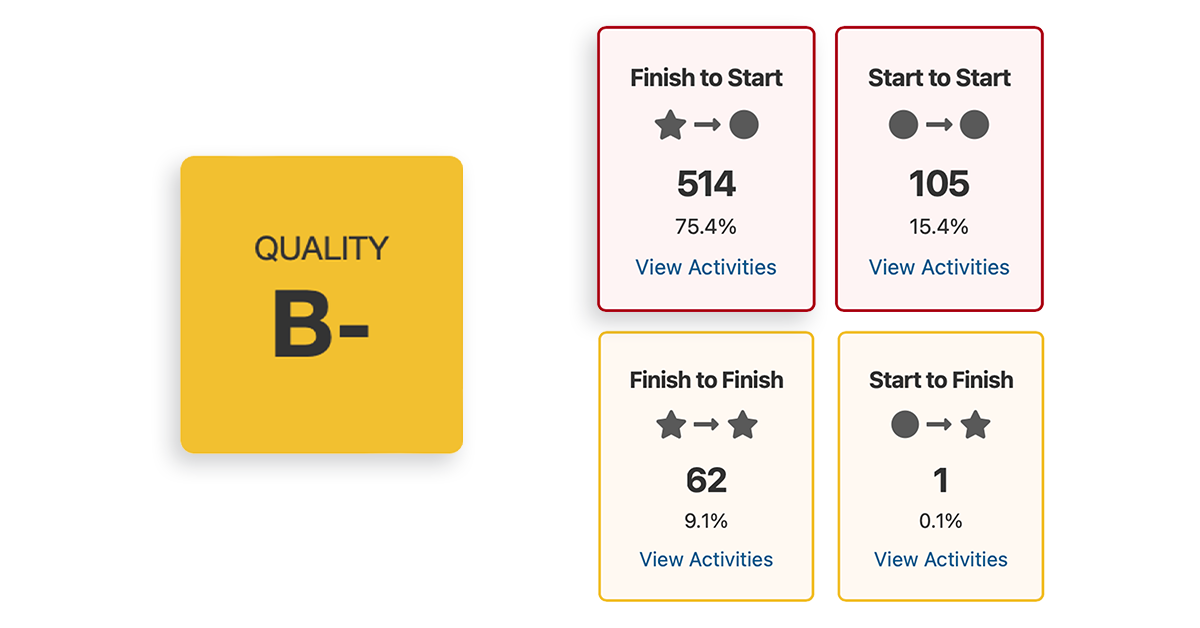Making sense of all of your data from all of your projects can feel like trying to understand a foreign language. But, when we break it down into steps, it starts to make a lot more sense.

- News
What Float in CPM Schedules Means for Your Construction Project
Achieving optimal project efficiency hinges on fully understanding the concept of float in CPM schedules. As we dive deeper into understanding its implications, and its effective management, you’ll discover the pivotal role it plays in ensuring projects run smoothly from start to finish.
What Is Float?
Whichever scheduling software you use, the CPM algorithm does the math. It calculates start dates, finish dates, and total float (often called slack). To simplify, total float is the room for delay an activity can have before impacting the end date of the job. The second type, free float, indicates how long you can delay an activity without delaying the subsequent tasks.
The Project Management Institute (PMI) notes that after calculating float, a series of critical activities appears. This sequence, known as the critical path, has the smallest amount of float and represents the project’s total duration. The term “critical” underscores the minimal slack in these activities– precisely, zero.
Float and Resource Management
Differentiating between an activity with two months of float and one with zero is extremely important for managing resources. Obviously, everyone sees a red path surrounded by green and blue activities. However, many do not look at float as an indicator of how to prioritize resources.

The critical path, highlighted in red, is your high-priority task list – where it’s most critical to prioritize your resources. Activities closely following this path, called the near-critical path, might vary in slack depending on the project’s size and complexity. Yet, any activity nearing 10-days of total slack is deemed “near-critical” by SmartPM standards. This, you should treat tasks with minimal slack (3-5 days) with the same sense of urgency as those on the critical path.
For instance, given two tasks with identical start dates, the one with less slack should receive more resources to remain on track. In essence, resource allocation to the areas with the least slack ensures a smoother progression of the project.
Determining Acceptable Values
Determining sufficient float values is a crucial aspect of project management and scheduling. Both companies and project levels set these values by weighing the appropriate risk thresholds.
For linear projects, I recommend minimizing float and lengthening the critical path to ensure steady project progression. On the other hand, for both horizontal and vertical projects, it’s vital to maintain a reasonable amount of float for all parties. A strategy to achieve this is by integrating crew logic into the scheduling process, which ensures that labor constraints are taken into account.
The goal is often to have a month or less of slack. Shorter slack durations allow for clearer visibility into when and where impacts happen. Having a tight schedule, meaning one that thinks through all necessary logic, allows for clear identification of the critical path that drives the project. This kind of robust scheduling ensures any impacts to the schedule can be identified and addressed promptly.
Slacking Off on Slack
Float is only as useful as the CPM schedule. This comes with the responsibility of ensuring your schedules are built with best practices. For example, if you have missing logic ties or a few bad practices built in, your critical path will be off, as will your slack values.
So, number one, ensure you have high schedule quality. In fact, several DCMA schedule quality checks are associated with float, including missing logic, high-float activities, and average activity total float.

Missing Logic
Every activity needs a predecessor or successor, except the very first and last. Ignoring this essential logic can result in skewed float values, altering the genuine critical path and rendering activity duration predictions unreliable. Furthermore, such gaps may conceal potential delays, impeding efficient analysis and informed decision-making.
High-Float Activities
A total float value of over 44 days presents a significant risk to a construction project. Excessive high-float activities (anything greater than two months) indicate flawed logic. As mentioned above, missing logic heightens the risks of hidden inefficiencies, delays, and an erroneous critical path.
In any case, schedules should have a minimal number of high-float activities. Ideally, schedules should be receptive to delays. Doing so allows project teams to gauge activity progression’s impact on the completion date.
Average Activity Total Float
Knowing the average amount of time your schedule’s activities have room for delay is helpful for two reasons. One, it informs you about the average permissible task delay without affecting the critical path. Secondly, if you have a high average, it could indicate an incomplete schedule. As mentioned above, incomplete schedules result in an erroneous critical path and the consequent challenges.
Staying Afloat
Float isn’t merely a project management metric; it’s a lifeline for ensuring successful project delivery. Apart from resource management, float offers:
- Flexibility and Contingency: Offering a buffer against unexpected challenges, float ensures activities can be postponed without jeopardizing the overall finish date.
- Cash Flow Management: If certain activities have float and require significant expenditure, then the disbursements can be adjusted accordingly.
- Decision Making: Float can influence priority decisions. For instance, if there are issues that might cause delays in multiple tasks, managers can use these values to decide which tasks should be prioritized to mitigate overall project delays.
- Stress Reduction: Instead of rushing to complete every activity, teams can work with a better understanding of which tasks have some leeway in terms of their completion dates.
- Stakeholder Communication: Slack provides a clear metric to communicate with stakeholders about potential delays and the flexibility present in the schedule. If a stakeholder is anxious about potential delays, understanding float can provide reassurance.
Adept management of the float in your CPM schedule can significantly elevate the success of your construction project. By understanding and leveraging float, you not only create a robust buffer against uncertainties, you also streamline resource allocation, foster informed decision-making, and ensure timely project delivery.
If you’d like to learn more about the importance of float in your schedule, fill out the form below. We’d be happy to provide you with additional context.
RELATED STORIES

Making Construction Data Analytics Easier to Understand
Making sense of all of your data from all of your projects can feel like trying to understand a foreign language. But, when we break it down into steps, it starts to make a lot more sense.

Overcoming Confirmation Bias in Construction Project Management
Confirmation bias can be particularly problematic in project and schedule management, where decisions must be based on accurate and comprehensive information.

Top Construction Scheduling Software in 2023
SmartPM’s recognition as a top construction scheduling software in 2023 attests to the immense value in automated project controls.

Putting the ‘Smart’ in Project Management with Project Controls
Project controls are not just a subset of project management; they are its backbone, focusing on meticulous monitoring and analysis.

